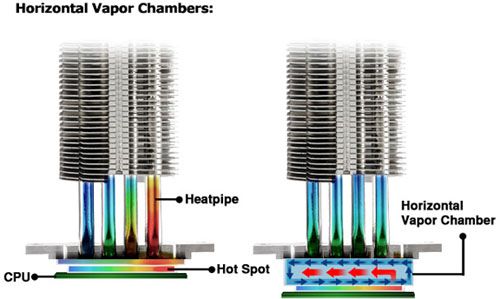I'm very interested to see how this goes. Newer processors are running cooler so having more efficient heat displacement should make pushing these chips easier. There has to be a break point at which coolant no longer vaporizes though. and cooling beyond that has little gain.
Boil points of coolants used:
Distilled, De-Ionized water - 100C = 212F
Methanol - 65C = 149F
Acetone - 56C = 133F
Vapor Chamber - Cooler Masterr
How do Vapor Chambers work?
As the coolant molecules are heated they change phases. The vaporized coolant convects freely through the chamber. The Molecules then condense on cold surfaces, dissipate their heat load, and are channeled back to the coolant reservoir.
So does this mean cooling the chamber below 56C (using Acetone) has little to no effect?
We have ammonia chillers at our plants that drop incoming air from ~100F down to 45F. Same principles apply but I don't know if there's enough volume, or that they can handle the
pressure, for it to work well.
Edit: I don't know if this technology is being used on graphics chips but I bet that platform will give the best result. Especially if my boiling point/cooling factor theory is correct. On second thought, the liquid only works sitting atop the chip, and usually they're facing downwards. I'd imagine that can be changed but requires OEM intervention.


